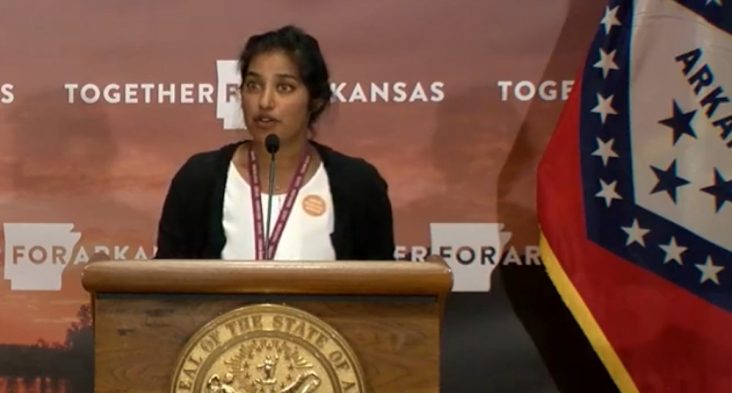Education boss: Arkansans must follow guidelines ‘if we want to make this work’
by August 24, 2020 4:13 pm 1,210 views

Dr. Tina Ipe, associate professor and medical director for the University of Arkansas for Medical Sciences Blood Bank and Transfusion Division
The return to school, blood plasma treatments and the need for more testing were key parts of Gov. Asa Hutchinson’s Monday (Aug. 24) COVID-19 briefing, with Arkansas Secretary of Education Johnny Key saying Arkansans must follow safety guidelines “if we want to make this work.”
Hundreds of thousands of students, educators, support staff and others returned Monday to in-class instruction at Arkansas public schools. Thousands of students elected to return to school only with virtual instruction. Gov. Hutchinson opened his briefing with a note to those returning to school.
“I particularly today want to say, ‘Thank You,’ to our teachers, our staff members, all of those educators that have worked hard, being ready for today, and the love that they have for the children who need the schooling this year,” he said.
When pressed about being ready to respond to reports of COVID cases in the schools, Key said there is “not one single indicator” that would cause a school or school building to close. Key and Gov. Hutchinson again referred to the three-response matrix unveiled in early July by the Arkansas Department of Education. Key also said state and school officials will work together on other options, such as reducing class sizes, before closing a school to all remote or an entire school system to all remote.
“I’m hoping we don’t ever have to go all remote in this school year,” Key said.
PLASMA AND TESTING
Gov. Hutchinson noted that although President Donald Trump over the weekend announced emergency use authorization (EUA) from the Federal Drug Administration for convalescent plasma, Arkansas was “ahead of the curve” in the treatment thanks to work conducted by the University of Arkansas for Medical Sciences.
Dr. Tina Ipe, associate professor and medical director for the UAMS Blood Bank and Transfusion Division, said the state began early to test the efficacy of using blood plasma from those who were infected by COVID-19 but recovered.
“Through this mechanism, we have done such a fabulous job in terms of Arkansans caring for other Arkansans that we have been able to provide two units of convalescent plasma for every hospitalized patient, and that is incredible,” Ipe said Monday.
Even in approving the EUA, the FDA said plasma treatment is not yet proven.
“Although promising, convalescent plasma has not yet been shown to be safe and effective as a treatment for COVID-19. Therefore, it is important to study the safety and efficacy of COVID-19 convalescent plasma in clinical trials,” the FDA noted in its Aug. 23 order.
Arkansas Secretary of Health Dr. Jose Romero said it is important for Arkansans to continue to test for COVID. He said local health units around the state will test “any and all comers” and people do not need to have symptoms or any reason to think they’ve been exposed to COVID to ask for a test.
.
“We want to continue robust testing throughout the state. We are starting to see a little bit of a slowdown. In order for our numbers to be predictive and to use for modeling into the future, and this is for schools, for making decisions, we need to have robust testing in our community,” Romero said.
COVID CASE NUMBERS
Known COVID-19 cases in Arkansas totaled 56,894 on Monday, up from 56,574 on Sunday, with 4,629 test results from the previous 24 hours. Of the 320 new cases, 11 were from correctional facilities. There are 5,509 active cases.
The number of deaths rose from 687 to 696. The number of COVID patients hospitalized in Arkansas was 466 on Monday, down from 500 on Sunday. There are 106 patients on ventilators, down from 110 on Sunday. There are 50,689 cumulative recovered cases.
The top five counties with new known cases were: Pulaski (46), Faulkner (36), Poinsett (23), Craighead (15) and Garland (11). The counties accounted for 42.4% of the 309 new community cases.
As of Monday at 1 p.m., there were 5,719,124 U.S. cases and 176,978 deaths. Globally, there were 23,507,852 cases and 809,958 deaths.
